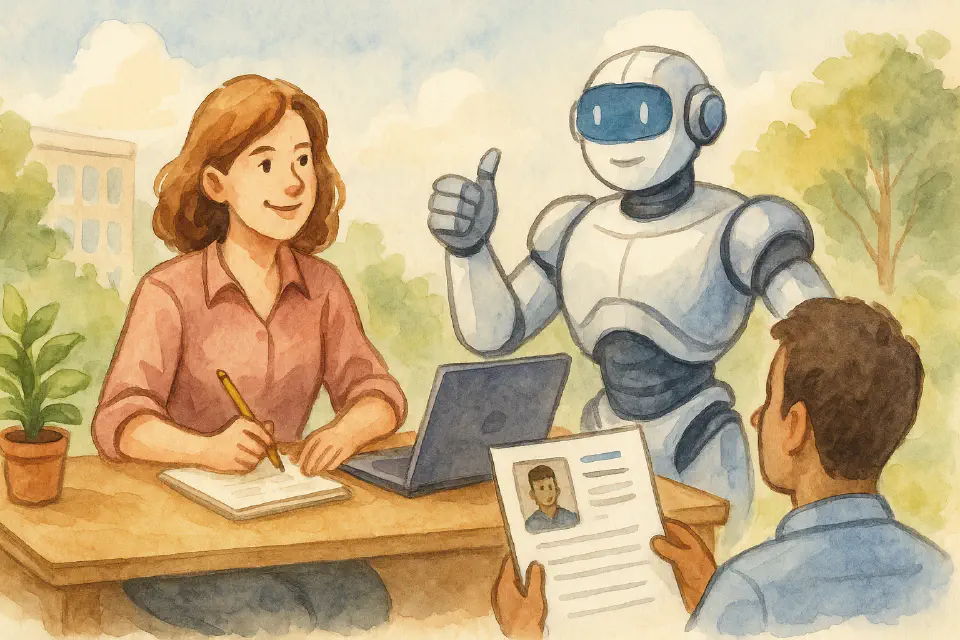
Smarter Recruiting with AI: 5 Practical Ways Talent Teams Can Work Faster and Better
AI won’t reinvent recruiting overnight—but it can make hiring faster, smarter, and a lot less painful. Here’s how talent teams can use AI tools today (without the hype).
AI in Recruiting: Practical Wins Without the Hype
Let’s be honest—recruitment has always been a pressure cooker. Rising application volumes, tight deadlines, limited resources… and now, AI is knocking on the door.
While job seekers are already using ChatGPT to polish resumes and tailor cover letters, many recruiters are still figuring out where AI fits into their workflow. The truth? It’s not about revolution. It’s about relief—clearing admin bottlenecks, writing better job ads, and giving your team time to actually recruit.
Here are five realistic, low-hype ways your talent team can start using AI—right now.
1. Automate the Admin That’s Draining Your Time
You didn’t become a recruiter to copy-paste job specs or manually format CVs. But let’s be real—that’s where a lot of your time goes.
Here’s where AI helps:
- Parse resumes and extract core competencies automatically
- Compare profiles to job descriptions using smart matching
- Summarize candidate experience and flag potential red flags
Think of it as a pre-screening co-pilot—not a replacement. It gives you a faster, cleaner starting point so you can focus on engagement, stakeholder alignment, and strategic decision-making.
2. Write Job Ads That Actually Work
Writing a great job ad is harder than it looks. You need to be clear, inclusive, and compelling—without sounding like a robot.
AI tools can help by:
- Drafting ad templates based on job specs
- Flagging jargon, bias, or legally risky language
- Suggesting clearer phrasing or alternative wordings
Use these tools to improve speed and consistency, especially across large recruiting teams. Just remember: always review with a human lens. Authenticity still matters.
3. Integrate AI Into the Flow (Not the Friction)
One reason AI tools get abandoned? They’re siloed.
If your recruiters have to open five tabs and export spreadsheets to use an AI feature, they won’t. The best approach is in-line integration—AI that shows up in tools they already use.
Examples include:
- Resume parsing inside your ATS or CRM
- Candidate summaries built into profile cards
- AI-based ranking right inside the shortlisting screen
No switching, no friction—just smarter tools where you need them.
4. Train Your Recruiters to Speak AI
This isn’t just a tech rollout—it’s a mindset shift.
If your team doesn’t understand prompt design, data privacy, or AI limitations, they won’t use it effectively—or worse, they’ll misuse it.
Start with:
- Basic training on prompt writing and use cases
- Examples of what AI can/can’t do
- Ongoing knowledge sharing from “AI champions” in your team
Confidence with AI grows with exposure. Make time to learn together.
5. Don’t Start With Tools—Start With Problems
Before buying another chatbot or scoring engine, ask: what’s the pain point?
Are you buried in applicants? Struggling with interview scheduling? Getting pressure for faster shortlist delivery?
Only then should you explore how AI might help. The best implementations start with a clear use case and grow from small experiments—not grand promises.
Final Recommendation
AI is not going to transform recruiting overnight. But it can transform how recruiters spend their time—away from low-value admin and toward high-impact conversations.
Start small. Start smart. And most importantly, start now.
Because in a world where talent is everything, the best teams will be those who use AI not to replace recruiters—but to empower them.